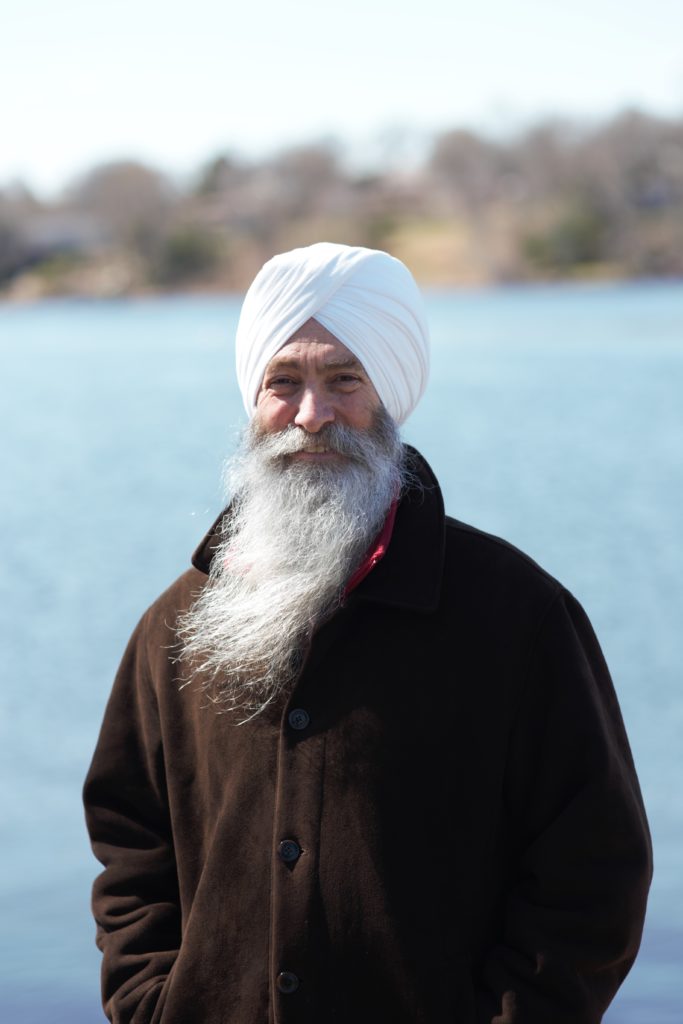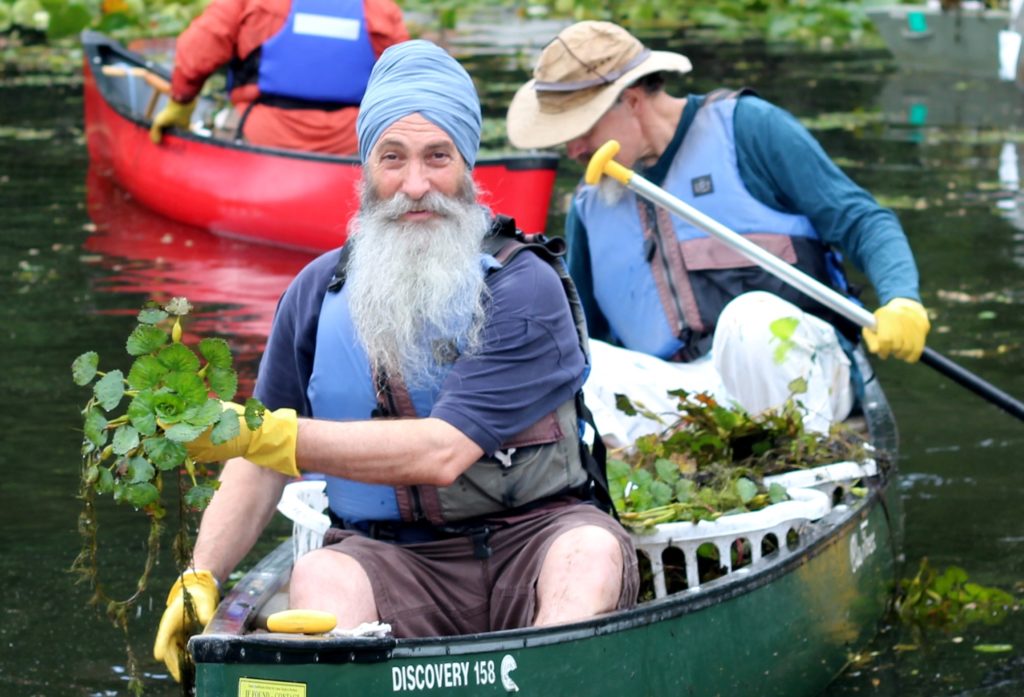Interview with an Environmental Change Agent
by Julia Blatt
EK (EkOngKar) Khalsa was executive director of Mystic River Watershed Association (MyRWA) from 2008 until this September. His leadership has resulted in a dramatic improvement in the environment and water quality in a vital Greater Boston natural resource. We asked Belmont resident Julia Blatt, executive director of the Massachusetts Rivers Alliance and longtime colleague of Khalsa, to speak with him about his accomplishments in the region.
 Julia Blatt: What brought you to the Mystic River Watershed Association?
Julia Blatt: What brought you to the Mystic River Watershed Association?
EK Khalsa: I was introduced to MyRWA by an inspiring, very dynamic member of the board of directors, Alison Cohen. Alison and I had worked together for months on a project to restore a contaminated orchard to productive use.
JB: Why did you decide to take on an environmental cause? What about this particular organization and cause appealed to you?
EKK: It was the passion that its board of directors, its members, and its small staff brought to the mission. When I reviewed the work that was underway, I realized that MyRWA was accomplishing so much with little funding and paid staff. It was a quixotic effort in some ways, a determination to make a difference in the lives of a half million by improving the local environment in a 76-square-mile area. I also loved that MyRWA celebrated the beauty and value of the natural world in all its richness in a very urban environment.
JB: What were you doing before joining MyRWA?
EKK: Before 2008, I worked for seven years as director of project development for Hallmark Companies in Hopkinton MA, under the direction of a visionary developer, Ron Roux. He was reconfiguring traditional residential subdivisions into open space plans that protected and preserved conservation land.
JB: What’s special about the Mystic River? What do you think most people don’t know about the Mystic that might surprise them?
EKK: Few people realize how great it is to swim in the Mystic Lakes in the summer, how tranquil the river is to canoe in fall, and how exciting it is to take a dip at Constitution Beach in East Boston in February!
JB: What have you seen change in your years at MyRWA, both within the organization, and for the river?
EKK: The most important change is the narrative of a forgotten, forlorn, polluted, urban waterway to the recognition that it is a vibrant living system full of fish, birds, and lush park space. The story of the Mystic is continuing to evolve in very positive ways, despite the significant challenges the watershed faces—particularly in its most urban sections.
The association had been struggling quite a bit just before I arrived because of very limited resources. The board was ready for a change when it hired me and we were fortunate to make significant organizational improvements.
When I arrived, MyRWA employed 2.5 full-time staffers, including me. The annual budget was approximately $150,000, including in-kind services. With that funding, they managed a very professional water-quality monitoring program, hosted sizable on-the-water events, wrote countless comment letters, and gave significant public testimony. This was done through sheer force of will and countless volunteer hours.
When I left office in September 2016, we had a staff of seven full-time professionals, a dozen paid consultants and interns, and more than 1,500 volunteers annually in various field and water quality improvement projects. The annual budget for 2016 will exceed $830,000. In addition, we’re helping to attract millions of dollars in private and public funding to improve environmental conditions in the watershed directly through our outreach and advocacy.
Much credit goes to John Reinhardt for bringing about such significant improvement. John guided the association as president throughout this period and helped to lay the groundwork for success before I arrived.
JB: What have been the obstacles the organization has faced?
EKK: One of the big challenges was overcoming the skepticism when I said that the Mystic was a beautiful river worth our investment. Few people had seen the river from the water’s surface. That distance makes engagement challenging.
The more people walk or ride their bikes on the riverfront, or spend time in a cleanup, or become a citizen scientists, however, the more voices call for support for the river’s health and well-being.
JB: What do you see as the greatest achievements of the group so far?
EKK: MyRWA made it clear that the river’s environmental condition was not solely the result of some bad people who made evil decisions in the distant past. We emphasized that the condition of the river is the direct result of the lives we are living now. That message has gotten out.
Today’s Mystic River residents are the beneficiaries of very successful urban development and extraordinary prosperity created by the folks who lived here before us. We are also the inheritors of the problems and inequities we collectively created.
We helped to create a balanced perspective based on the facts and articulated that it is possible to achieve clean water, a healthy river, and vibrant, inclusive communities. We have also made clear that there‘s a price to pay for that.

EK Khalsa, staff, and volunteers removed thousands of water chestnut plants from the river.
JB: Of what are you most proud?
EKK: That we persuaded US Environmental Protection Agency to change the Mystic River Watershed water-quality grading system to better reflect the actual conditions in the river. That really helped develop a better understanding of where the treasures and challenges lie.
I’m most proud that I helped guide my staff and many young interns and volunteers to accomplish work of which they are proud and which, I believe for them, is deeply meaningful.
JB: What are the challenges still ahead?
EKK: To maintain current capacity, to secure steady funding for professional staff on whom so much of this work depends, and to continue to build strong coalitions and collaborative efforts among a diverse group of stakeholders.
The challenge for the watershed will be to embrace and guide the explosive growth and development that will be initiated by the Wynn Resort Casino in Everett. Few people realize, I suspect, the profound and immediate impact this facility will have on local real estate and riverfront sites.
Few people realize the profound and immediate impact [the Wynn Resort Casino] will have on local real estate and riverfront sites.
It is important for the association and many other Boston regional advocates promote healthy land use and generous consideration of the Mystic and its parklands as this growth unfolds.
There’s an opportunity to get it right this time but there will be a need for many voices in the chorus.
JB: What takes you to California now? And what will you be doing there?
EKK: My wife Savitri and I have moved to be closer to our only child. I will also serve as the first executive director of the Amah Mutsun Land Trust, founded by the native people of the lands around Santa Cruz and Monterey, California.
Julia Blatt is a Belmont resident and executive director of the Massachusetts River Alliance.


Sorry, the comment form is closed at this time.